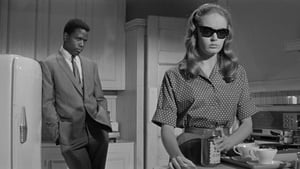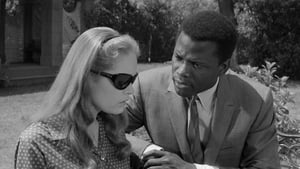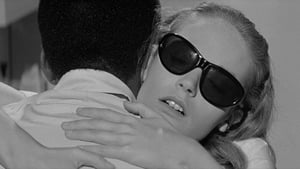Contact: [email protected]
Video Sources 0 Views

Synopsis
[ez-toc]





Introduction
A Patch of Blue Colorized, released in 1965 and helmed by Guy Green, is a thought-provoking and poignant American drama that delves into the complexities of friendship amidst a racially divided society. The film revolves around the extraordinary bond formed between an erudite African-American man, brilliantly portrayed by Sidney Poitier, and an uneducated, blind, and young white girl of eighteen, skillfully brought to life by Elizabeth Hartman in her impressive debut performance. Set against the backdrop of the burgeoning civil rights movement, this movie delves deep into the pervasive issues of racism while cleverly exploring the notion that true love knows no color or prejudice.
Shelley Winters, a highly accomplished actress, emerged victorious at the prestigious Academy Awards by securing the esteemed Best Supporting Actress accolade. This remarkable achievement marked her second triumph in this category, as she had previously been honored with the same award in 1959 for her stellar performance in the renowned film The Diary of Anne Frank.
Notably, this particular victory served as a testament to Winters’ exceptional talent and dedication to her craft. Additionally, it is worth mentioning that this award-winning moment coincided with a significant milestone in the world of cinema, as it marked the final appearance on the silver screen for the esteemed and revered actor Wallace Ford, who had graced the industry with his remarkable talent for many years.
The film theaters in the Southern United States decided to remove the scenes of Poitier and Hartman kissing from A Patch of Blue, resulting in a shorter version being shown to audiences. However, these scenes were included in the DVD version of the film. The director, Guy Green, made the deliberate choice to film the movie in black and white, even though color technology was accessible at the time.
Guy Green adapted the film from Elizabeth Kata’s 1961 book Be Ready with Bells and Drums, which later received a Writers Guild of America award. The film’s ending is more hopeful compared to the book’s slightly less upbeat conclusion.
Apart from winning the Best Supporting Actress award for Shelley Winters, the film also received nominations for several other Academy Awards. Elizabeth Hartman, who played the leading role, was nominated for Best Actress. The film was also recognized for its exceptional art direction, with George Davis, Urie McCleary, Henry Grace, and Charles S. Thompson being nominated for Best Art Direction-Set Decoration in the black-and-white category. Additionally, the film received a nomination for Best Cinematography in black-and-white, as well as Best Music for its original score. At the young age of 22, Hartman became the youngest ever Best Actress nominee, a distinction she held for a decade until Isabelle Adjani, who was only 20 years old, surpassed her in 1975.
Read Media File Transfer Agreement: Terms and Conditions
Read FAQ
The Journey of A Patch of Blue Colorized: From Black and White to Color
Selina D’Arcey, a young girl with a visual impairment, resides in a modest city apartment alongside her mother Rose-Ann, who is known for her impolite and offensive behavior due to her profession as a prostitute. In addition to Rose-Ann, Selina lives with her grandfather Ole Pa, who struggles with alcoholism. To contribute to her family’s limited finances, Selina engages in the task of stringing beads, while also dedicating most of her time to fulfilling household chores. Unfortunately, Selina endures abuse from her mother and leads an extremely isolated life, rarely venturing outside of the apartment. Tragically, she has also been denied the opportunity for formal education, resulting in her lacking any form of companionship or social interaction.
Despite the darkness that loomed over Selina’s past, her connection with Gordon provided a glimmer of hope and companionship in her otherwise tumultuous life. Their daily meetings at the park became a source of solace and comfort for Selina, offering her a reprieve from the pain and trauma she had endured. In Gordon, she found a friend who not only understood her struggles but also provided unwavering support and understanding.
Selina’s persuasive skills finally paid off when she managed to convince her reluctant grandfather to take her to the park. It was there that she fatefully crossed paths with Gordon Ralfe, a well-educated and articulate black man who worked the night shift at an office. Despite their stark differences in background and experiences, the two formed an instant bond and began meeting at the park regularly.
Rose-Ann and Sadie, who are both prostitutes, are feeling nostalgic about their younger years. During their conversation, they come to the realization that Selina, their mutual acquaintance, could potentially be a valuable asset in their line of work. Motivated by this idea, Rose-Ann and Sadie make the decision to abandon Ole Pa, their current living situation, and instead move into a more desirable apartment with Selina. Furthermore, they plan to coerce Selina into entering the world of prostitution.
During Rose-Ann’s absence, Gordon has arranged for Selina to attend a school for the blind. Selina, feeling restless, decides to run away to the park where she meets Gordon. She confides in him about Rose-Ann’s intentions, and he reassures her that she will be leaving for school soon. When Rose-Ann realizes Selina is missing, she goes to the park with Ole Pa and confronts Gordon. Despite Rose-Ann’s protests, Gordon successfully takes Selina with him as onlookers disapprove of Rose-Ann’s behavior. Ole Pa advises Rose-Ann to let Selina go, insisting that she is no longer a child.
Selina, at Gordon’s house, proposes to him and expresses her love, but Gordon gently explains that there are different kinds of love and their relationship may not be sustainable in the long run. Selina reassures him that she loves him for who he is, regardless of his race. Gordon advises her to meet more people and give their love some time to grow before making any decisions. As Selina boards a bus for school, Gordon gifts her a music box that belonged to his grandmother. When she forgets it at his place, he rushes to return it but misses the bus. Disappointed, he heads back to his apartment.
A Patch of Blue Colorized Film Cast
The cast of the film includes Sidney Poitier in the role of Gordon Ralfe, Shelley Winters as Rose-Ann D’Arcey, Elizabeth Hartman as Selina D’Arcey, and Debi Storm portraying a young Selina D’Arcey at the age of 5. Wallace Ford appears as Ole Pa, Ivan Dixon as Mark Ralfe, Elisabeth Fraser as Sadie, John Qualen as Mr. Faber, Kelly Flynn as Yanek Faber, Renata Vanni as Mrs. Favaloro, Saverio LoMedico as Mr. Favaloro, and Casey Merriman as Casey M.
A Patch of Blue Colorized Critical reception
The New York Times offered a critical assessment of “A Patch of Blue,” expressing doubts about the sincerity of its intentions. They found the drama to be overly contrived, with characters that felt too neatly packaged and a storyline that seemed too formulaic. The reviewer questioned the authenticity of the setting and the actions of the characters, noting inconsistencies that detracted from the film’s realism. Overall, the review suggested that the film lacked the raw, human emotions that would have made it a more genuine and impactful viewing experience.
The Chicago Tribune article discusses the portrayal of the Wicked Stepmother character in a new film, played by Shelley Winters. Despite not being an actual step relative, Winters embodies the wickedness of the character with convincing intensity. Alongside her is a gin-guzzling grandfather, adding to the dysfunction in the protagonist’s life. The park serves as a refuge for the young girl, where she meets a kind and practical young man portrayed by Sidney Poitier. Selina, played by newcomer Hartman, navigates the melodramatic script with grace, capturing the complexities of her character’s transformation from isolation to joy in the park.
The review of “A Patch of Blue” in TIME magazine was a bit mixed, with the reviewer stating that it took some time to get used to the film. Initially, they found it to be a pointless tearjerker, but then it unexpectedly transformed into a story of contemporary hope. To rescue the film from its own shortcomings required exceptional talent, and fortunately, the movie had skilled individuals involved. Director Guy Green, in particular, demonstrated his ability to sustain an idea that could easily slip into excessive sentimentality in less capable hands.
Green’s style was described as uncomplicated, yet powerful and authentic, consistently bringing out the remarkable inner resources of the actors. The standout performer in the cast was Elizabeth Hartman, a 21-year-old newcomer to the film industry. Her portrayal in “Patch of Blue” was praised for its quiet and tender moments, which helped to overcome the superficiality of a plot that reduced complex human issues to a simple narrative of a blind person being guided by a black individual. The film openly explored interracial love but left it unresolved in the end, making the overall message of the movie almost inconsequential.
A Patch of Blue has received overwhelmingly positive reviews on Rotten Tomatoes, boasting an impressive approval rating of 89% based on a total of nine carefully scrutinized reviews.
A Patch of Blue Colorized Box-office
The box-office performance of the film exceeded all expectations and ultimately became the highest-grossing film in Poitier’s illustrious career. Despite initially agreeing to a reduced salary, Poitier’s decision to receive 10% of the film’s earnings paid off handsomely, leading to a significant financial windfall. Furthermore, the success of the film elevated Poitier to the status of a major national film star, with widespread popularity even in traditionally conservative southern cities such as Houston, Atlanta, and Charlotte.
Awards and nominations
The movie has been acknowledged by the American Film Institute through various prestigious lists. In 2002, it was nominated for AFI’s 100 Years…100 Passions. Additionally, in 2005, it received another nomination for AFI’s 100 Years of Film Scores. These accolades highlight the film’s enduring impact on the cinematic landscape and its ability to resonate with audiences through its compelling storytelling and memorable soundtrack.
A Patch of Blue Colorized Soundtrack
Jerry Goldsmith composed and conducted the soundtrack for the film A Patch of Blue, which earned him his second Academy Award nomination for Best Original Score. This recognition came after his previous nomination for his score in the film Freud back in 1962. Notably, the soundtrack was among the 250 nominated scores for the American Film Institute’s prestigious top 25 American film scores list. The popularity and acclaim surrounding the score led to its release on CD three times.
Firstly, in 1991 through Mainstream Records, alongside the score to David and Lisa by Mark Lawrence. Secondly, in 1992 through Tsunami Records, alongside Goldsmith’s score for the film Patton. Finally, an extended version was released in 1997 through Intrada Records, showcasing the continued appreciation for Goldsmith’s remarkable musical composition.
The film’s creators also produced a short film that highlights Hartman’s journey to landing the lead role. Titled A Cinderella Named Elizabeth, the short film delves into her background as a relatively unknown actress hailing from Youngstown, Ohio. It showcases snippets from her audition and “personality test”, where she is candidly filmed answering questions about her personal style and preferences. Additionally, the short film captures her visit to the Braille Institute of America, where she observes visually impaired individuals learning skills similar to the beadwork her character performs in the movie. This visit also includes demonstrations of daily tasks and self-care routines, mirroring the lessons Poitier’s character imparts to Selina in the film.














